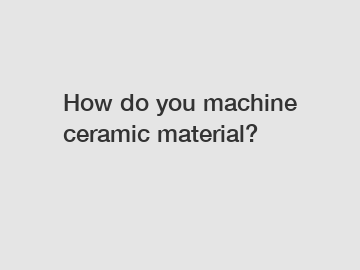Dec. 01, 2023
Minerals
In the realm of engineering, ceramics have long held their place as one of the most fascinating and versatile materials. Known for their exceptional hardness, high-temperature resistance, and excellent electrical insulation properties, ceramics find applications in diverse fields ranging from aerospace to healthcare. However, machining ceramic materials is no small feat. It demands a fine balance between expertise, precision, and advanced techniques. In this blog, we will explore the process of machining ceramic materials, providing insights into this intricate craft.
Understanding Ceramic Materials:
Ceramic materials are inorganic, non-metallic substances consisting of compounds made of metal and non-metal atoms. They exhibit varying properties depending on their composition and structure. While ceramics are admired for being exceptionally hard, they are also brittle, which makes machining them challenging. The machining process must be carefully executed to avoid fracturing or chipping the material.

1. Types of Ceramic Materials:
There are several types of ceramic materials, each with its own unique properties and considerations for machining. Some common ceramic materials include alumina oxide, zirconia oxide, silicon carbide, and silicon nitride. Understanding the specific characteristics of the material being machined is crucial for selecting appropriate tools and techniques.
2. Machining Techniques:
2.1 Diamond Tools: Diamond tools are widely used for machining ceramics due to their exceptional hardness. Diamond-tipped cutting tools or grinding wheels are carefully engineered to withstand the high pressures involved in ceramic machining. The tools must be precisely aligned to maintain a consistent cutting edge and minimize the risk of fractures.
2.2 Grinding: Grinding is a commonly used machining process for ceramics. It involves the use of abrasive wheels to remove material in a controlled manner. Coolants or lubricants may be used during the process to manage heat buildup and prevent thermal damage to the ceramic material.
2.3 Laser Machining: Laser machining offers a high-precision alternative for machining ceramics. It utilizes a highly focused laser beam to remove ceramic material. This technique is especially effective for creating intricate designs or micromachining ceramic components.
Further reading:3. Challenges and Considerations:
Machining ceramic materials requires a deep understanding of their inherent challenges. Due to the brittleness of ceramics, vibrations or thermal stresses can lead to fractures during the machining process. To mitigate these risks, it is essential to prioritize rigidity and stability when designing machining setups. Using appropriate workholding techniques and minimizing tool runout can help ensure successful machining outcomes.
4. Post-Machining Processes:
Once the desired shape has been achieved, post-machining processes may be required to refine the ceramic components. These may include polishing, lapping, or surface treatment to enhance surface finish, accuracy, and overall component performance.
5. Expertise Matters:
Machining ceramic materials is a specialized craft that demands expertise and experience. A deep understanding of material properties, tool selection, and machining techniques is critical for achieving desirable outcomes. Working with experienced technicians or dedicated ceramic machining experts enhances the likelihood of success, enabling complex designs and intricate structures.
Conclusion:
Machining ceramic materials is a fascinating blend of science, art, and precision engineering. Whether it is aerospace components, biomedical implants, or cutting-edge electronic devices, ceramic materials play a vital role in modern technology. By harnessing advanced techniques, expertise, and a deep understanding of material behavior, we can unlock the true potential of ceramics. Successful ceramic machining allows us to push boundaries and create applications that were once deemed impossible. So, the next time you marvel at a ceramic wonder, remember the extraordinary craftsmanship that lies behind its creation.
The company is the world’s best Fiberglass filter bag, Ceramic Honeycomb Screen, Ceramic Foam Filter Manufacturing Process supplier. We are your one-stop shop for all needs. Our staff are highly-specialized and will help you find the product you need.
Further reading:Related Articles
If you are interested in sending in a Guest Blogger Submission,welcome to write for us!
All Comments ( 0 )